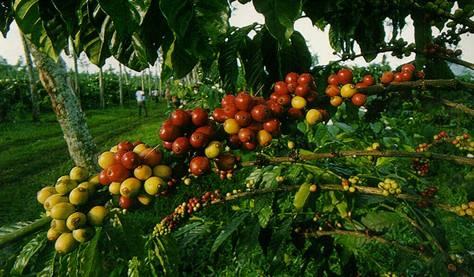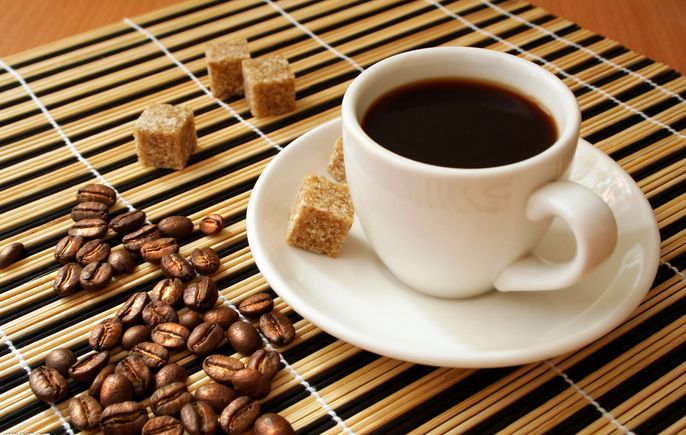Theoretical study, from coffee tree to coffee
Follow the caf é (Wechat official account vdailycom) and found that Beautiful Cafe opened a small shop of its own.
-- split line--
Coffee is a perennial evergreen shrub or small tree of Rubiaceae. It is a horticultural perennial cash crop with the characteristics of fast growth, high yield, high value and wide market. Wild coffee trees can grow to a height of 5 to 10 meters, but coffee trees planted on the manor are often cut to less than 2 meters in order to increase their fruit and facilitate harvesting.
The first flowering period of the coffee tree is about three years old. the five-petal tube-shaped white flowers are filled with a faint scent of jasmine and the inflorescences are arranged in dense clusters. Flowers wither after two or three days of blooming and begin to bear fruit after a few months. The fruit is a drupe with a diameter of about 1.5cm. It turns green at first, then turns yellow gradually, and turns red when ripe. It is very similar to cherries, so it is called cherry coffee (Coffee Cherry). It can be harvested at this time.
Coffee fruit contains two seeds, namely coffee beans. The two beans are connected face to face with each other on one side of the plane. Each coffee bean has a thin outer film, which is called silver skin, and its outer layer is covered with a yellow outer skin, called endocarp. The whole coffee bean is wrapped in a sticky pulp to form the coffee pulp, which is soft and sweet, with the outer shell.

Raw bean processing
Pick
The existing coffee picking methods are divided into mechanical picking and manual picking. Mechanical picking is suitable for coffee gardens with flat land and large areas of planting. Brazil is the most frequent user of mechanical picking coffee in the world. This method is characterized by low cost and high efficiency, but the coffee beans picked are uneven and of poor quality. For coffee beans with higher quality requirements, the method of manual picking is generally adopted, which ensures that the picked coffee fruit has uniform size, similar maturity, no other impurities, and is beneficial to the post-processing of coffee beans.
From fruits to coffee beans
The processing methods from coffee fruit to coffee beans can be roughly classified as dry processing and wet processing.
Dry processing: the coffee fruit is dried and dehydrated by natural conditions such as sunlight and ventilation, and then the dried coffee fruit is put into the peeled pulp, peel and silver skin. This method is the most economical and traditional processing method, the coffee beans treated by this method can maintain the fragrance for a long time, but also have a certain environmental smell. At present, this method is widely used in many parts of Africa and Asian countries, but with the progress of science and technology, many places have begun to use dryers to dry coffee fruit.
Wet processing: also known as water washing processing, using soaking to screen the coffee fruit, and then the selected fruit through fermentation, extrusion and other methods to remove the peel, pulp and silver surface slippery pulp, processed coffee beans will retain the surface of the silver skin for storage, this state of coffee beans called "parchment coffee beans" (Parchment Coffee), until export before using the peeling machine to remove the dried silver skin. The biggest advantage of wet processing is that the appearance quality of coffee beans is good, and the original flavor is maintained well. The disadvantage is that the processing cost is high and a lot of water is needed. It is generally used for the processing of high quality coffee beans.
Baking
Coffee bean roasting is a process in which raw beans are converted into sugars and acids by means of specific equipment at high temperature. in this process, substances such as cellulose will be carbonized to varying degrees, water and carbon dioxide will be volatilized, and the protein will be converted into enzymes, which combine with the rest of the fat to form an oil film on the surface of the coffee, and the coffee bean itself will expand by baking. Pores are created inside. Roasted coffee beans can produce special aromas and different flavors before they can be used to brew coffee.
Coffee bean roasting is a complicated processing technology, which is quite professional. If you want to make delicious coffee beans, you need perfect equipment and high coffee roasting technology, so unless it is for personal pleasure, it is generally not suitable for family.
With the size of the baking firepower, the length of time, coffee beans will show different depth and taste changes. Different characteristics of coffee beans, different drinking methods determine the depth of roasting of coffee beans. Generally speaking, the roasting degree is light, the coffee bean color will be light brown, the sour taste is strong, and the baking degree is deep, the hue is dark, and the bitterness is enhanced.
Traditionally, the roasting of coffee beans is divided into eight different degrees:
The lightest baking (Light)-slightly yellowish coffee color, not very strong aroma and flavor
Light roasting (Cinnamon)-cinnamon color, slightly better flavor, a kind of American coffee
Ordinary roasting (Medium)-maroon, mellow, moderately sour, a kind of American coffee
Medium baking (High)-A slightly thicker baking method than shallow baking, with bitter acid and good aroma and flavor.
Medium and deep roasting (City)-the word City- comes from New York City and is a standard roasting method suitable for Colombian and New York-style coffee
Strong roasting (Full City)-no sour but bitter, suitable for iced coffee
Strong roasting (French)-French, also known as European style, due to the strong degree of baking, coffee beans fat oozing surface, dark color, strong bitterness, with a unique flavor
The strongest roasting (Italian), also known as Italian style, has a strong roasting degree, and the coffee beans are carbonized black, scorched and without aroma, so they are suitable for brewing Italian steam coffee.
Important Notice :
前街咖啡 FrontStreet Coffee has moved to new addredd:
FrontStreet Coffee Address: 315,Donghua East Road,GuangZhou
Tel:020 38364473
- Prev

Theoretical study, the Origin of Coffee
Following Ka Ping (Wechat official account vdailycom) found that Beautiful Cafe opened a small shop of its own-- Segmentation Line. There is no way to find out the origin of coffee. One of the many legends refers to the coffee origin in the province of Kaifa in southwestern Ethiopia
- Next

See how Starbucks trains and retains baristas
Now, the pace of life is speeding up, and most people who have been busy all day like to stay at home, while some people say that except for going home to sleep, I spend almost all my time in the store because I like it. This is the real idea of post-90s Binbin, a barista who currently works in a Starbucks coffee shop in Shenzhen. Binbin likes coffee and has been learning coffee since he became a barista.
Related
- What is the meaning of lactic acid fermentation with coffee bean treatment?
- How to judge the state of foam by sound?
- How does the latte pull out the unicorn pattern? Come to get for a little trick to improve the flower pull!
- Will flower pulling affect the taste of the latte?
- Do you know the history of coffee?
- The difference between honey treatment and sun washing what is raisin honey treatment?
- What kind of milk can a novice use to make coffee foam to keep the foam longer? The correct method and skills of milking tutorial sharing
- Why do washed coffee beans taste sour? Flavor characteristics of washed Coffee
- Introduction to the skill of how to practice the size and height of water injection around the circle of hand-brewed coffee
- How do beginners practice coffee flower drawing from scratch?

